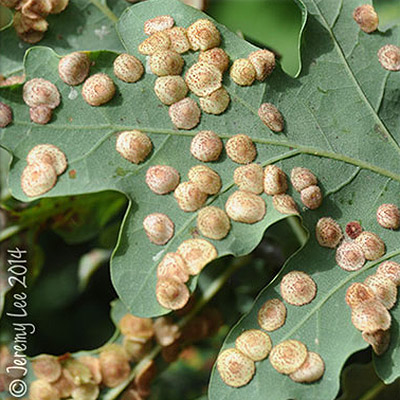
 |
|
Scientific Classifications explained » Amphibians » Ants » Aphids » Bees » Beetles » Birds » Bugs » Butterflies » Caterpillars » Damselflies » Dragonflies » Earwigs » Flies » Frog/Leafhoppers » Fungi » Galls » Grasshoppers » Harvestmen » Hoverflies » Lacewings » Ladybirds » Leaf Mines » Lichens » Mammals » Millipedes » Mosses » Moths » Sawflies » Slugs » Snails » Spiders » Trees » Wasps » Wild Flowers » Woodlice |
UK Nature > Galls > Oak Spangle Gall

Gall causer: Neuroterus quercusbaccarum Common Name: Oak Spangle Gall The Oak Spangle Gall is caused by the cynipid wasp Neuroterus quercusbaccarum, which has both agamic and bisexual generations, causing different galls to occur on Oak. The gall is more likely to be seen than the adult wasp. The male and female of the bisexual generation emerge in June from Currant Galls which are spherical, smooth, succulent, berry-like galls up to 7 mm in diameter which vary in colour from pale yellow through green to red or purple.These galls may occur on Oak leaves or catkins. After mating the fertilised eggs are laid by the sexual generation in the lower epidermis of the Oak leaves. The Spangle Galls develop over the winter and the insects emerge in April, laying their eggs in the catkins or lower epidermis of leaves. The cycle, an alternation of generation, then begins again. Common and widespread throughout the UK. |
|

https://www.uknature.co.uk is a website dedicated to showing the immense diversity of UK nature and wildlife. Our vast range of habitats, from lowland arable to snow covered mountains, from storm-ravaged coastlines to peaceful inland freshwater lakes and rivers, from dry, sandy heaths to deciduous and coniferous forests, all these habitats contribute to the abundance of UK nature. We have wild birds in huge numbers either residing or visiting our shores (597 recorded species as at July 2013) and we must also not forget the humble back garden with its grass lawns, flower beds filled with nectar rich flowers, shrubs and trees, all designed to attract huge numbers of insects such as bees, moths, butterflies and hoverflies; and finally the small ponds which provide safe havens for frogs, toads, newts and even slow worms and grass snakes. www.uknature.co.uk is the showcase for my personal passion, photographing uknature in all its glory. I sincerely hope you all enjoy the fruits of my labours. This site and all images contained therein is © Jeremy Lee 2004 - 2021. All Rights Reserved. Site design by Jeremy Lee. Site development & IT Support by Stuart Lee. |